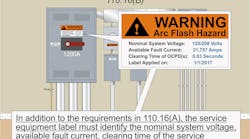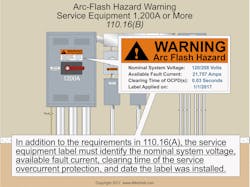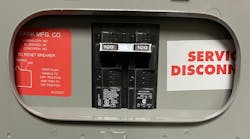Underlined text indicates a change in the rules for the 2017 NEC.
Q. Does the Code have service equipment fault current labeling requirements for services rated 1,200A and more?
Scroll Down to See the Answer
A. Yes. Service equipment rated 1,200A or more must have a field or factory installed label containing the following details and have sufficient durability to withstand the environment [110.16(B)]:
(1) Nominal system voltage
(2) Available fault current at the service overcurrent protection device
(3) Clearing time of the service overcurrent protection device based on the available fault current at the service equipment
(4) Date the service equipment available fault current label was installed
Exception: Service equipment labeling isn’t required if an arc‑flash label in accordance with NFPA 70E, Standard for Electrical Safety in the Workplace, [see Note 3] is applied.
Note No. 1: NFPA 70E, Standard for Electrical Safety in the Workplace, provides guidance in determining the severity of potential exposure, planning safe work practices, arc-flash labeling, and selecting personal protective equipment.
Note No. 3: NFPA 70E, Standard for Electrical Safety in the Workplace provides specific criteria for developing arc-flash labels, such as nominal system voltage, incident energy levels, arc-flash boundaries, and selecting personal protective equipment.
These materials are provided to us by Mike Holt Enterprises in Leesburg, Fla. To view Code training materials offered by this company, visit www.mikeholt.com/code





